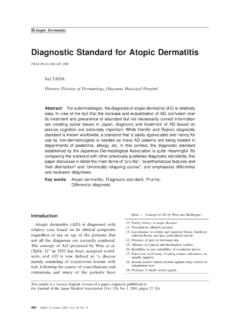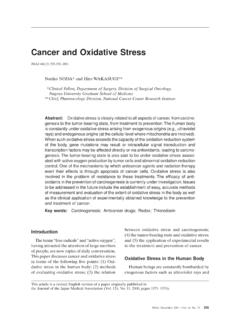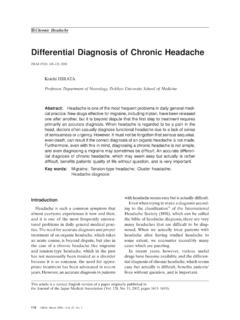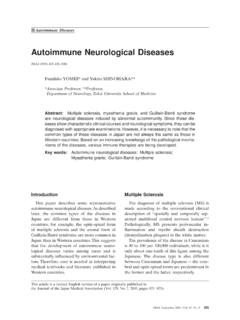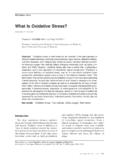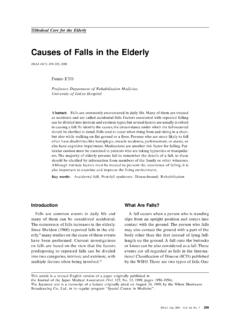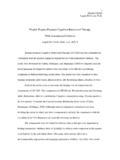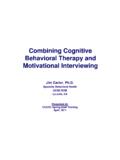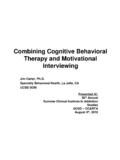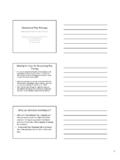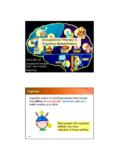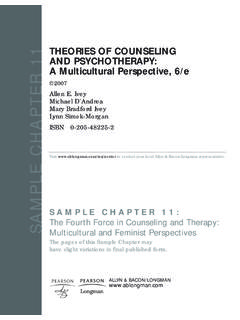Transcription of Behavior Therapy for Obesity - Med
1 539 JMAJ, November 2005 Vol. 48, No. 11*1 Institute of Behavioral Health, FukuokaCorrespondence to: Yoshiko Adachi MD, Institute of Behavioral Health, 3-29-11 Ishizaka, Dazaifu, Fukuoka 818-0118, : 81-92-919-5717, Fax: 81-92-928-9522, E-mail: ArticleBehavior Therapy for ObesityJMAJ 48(11): 539 544, 2005 Yoshiko Adachi*1 AbstractBehavior Therapy for Obesity aims to make lifestyle modification necessary for weight loss in areas such as dietand exercise. It had been found that Behavior Therapy promotes weight loss and its maintenance by increasingtreatment compliance.
2 Lifestyle modification is regarded as essential for any treatment of Obesity such asmedication, dieting, surgery often tend to be unwilling to use Behavior Therapy in clinical practice considering it time-consuming and skill-intensive. However, Behavior Therapy for Obesity can be standardized and used more non-face-to-face Therapy and computer-assisted Therapy have also been developed. We can usethese materials achieve the goals of Behavior Therapy , that is, to change habits and to maintain these changes, it isnecessary to promote patient s self-care and to maximize the patient s own ability to undertake this.
3 Above allbehavioral techniques, the theory and the principle of operant conditioning that voluntary Behavior is reinforcedby the contingency of the Behavior is the most fundamental and therefore also an indispensable principle ingeneral clinical is also necessary to ascertain the patient s readiness to lose weight and to adjust guidance targetsaccordingly. Patients who demonstrated sufficient readiness were able to achieve an average weight loss ofabout BMI kg/m2 by correspondence intervention with target setting and one month s self-monitoringfollowed by six-months of regular observations only.
4 Therefore if health professionals utilize these readymadeeducational materials and programs, they could save their limited time in creating an effective environment inwhich to motivate patients and manage their wordsBehavior Therapy , Obesity , Lifestyle modification, Self-care, Computer-assisted programthe 1960s, when Obesity treatment first beganto be taken seriously, the core challenges havebeen, and still remain that of motivating patientsand of maintaining weight loss. By nature, manyhuman beings prefer to eat as much as theywant and like an easy life by avoiding society has responded to these desireswith the ready availability of convenience foodsand the ever-increasing reliance on automatedand motorized transportation.
5 As a result, simple,healthy practices such as eating moderatelyand walking for an extra 20 minutes each dayrequire even greater amounts of self-control andeffort. Behavior Therapy is psychotherapy thatconsiders such human traits and tries to modifyIntroductionThe maintenance of a reasonable body weight isa base of the treatment of diabetes, hypertensionand hyperlipidemia. Even slight weight loss ofabout 5% of initial body weight could bringsignificant clinical improvement.
6 In order toreduce excess body fat, the energy balance hasto be kept negative by reducing food intakeand increasing physical activities. As simple asthis might seem in theory, in practice it can beextremely difficult to accomplish. Even if weightloss can be achieved in the short-term, it is evenmore difficult to maintain in the long-term. Since540 JMAJ, November 2005 Vol. 48, No. 11 Adachi Yhabitual behaviors. Its application to obesitystarted in the 1960s and its impact on motivationand the maintenance of effects became wellestablished in the to practical time constraints medicalprofessionals tend to be reluctant to usepsychotherapy, and behavioral change with theirpatients.
7 They have also tended to underestimatethe educational effects. However, in the author sexperience weight reduction has been achievedby setting targets and self monitoring in a grouptreatment2 and also our original non face-to-face program which provides Use of this program has shown that itis possible to standardize Behavior Therapy andfacilitate paper gives an overview of behaviortherapy for Obesity , offers key pointers, andalso describes specific ways in which medicalprofessionals can promote and encourage self-care of of Behavior Therapy and ItsProblem-Solving MethodsThe aim of Behavior Therapy is to increase thepatient s capacity for self-control.
8 Existing habitsare considered learned behaviors to be changedgradually through a logical and methodicalproblem-solving approach. Initially, the problemis identified and described in terms of specificbehaviors. These behaviors are then analyzed forstimulus-response relationships (Fig. 1). Duringthis process, minute observations are made aboutthe kinds of behaviors that happen at specifictimes and the consequences of those take the example of excessive drinking, thepatient returns home in the evening and isbored on his own, he drinks too much beer,which he subsequently regrets.
9 And as a resultof the negative emotion wants to drink environment and associated conditions areassumed to play a part in generating andsustaining the problem Behavior . Once thesehave been identified, the patient can beencouraged to make changes in the environmentso that the likelihood of desirable Behavior isincreased. Decision-making about subsequentcourses of action is then dependent uponpatients actual Behavior and ability to invokechange, in relation to the first analysis.
10 Thusbehavior Therapy is evidence based, and thepatient s efforts are Therapy is the clinical applicationof behavioral sciences and is a general termfor Behavior correction and cognitive From the 1950s it came to be usedmainly for problem Behavior that is difficult todeal with in the psychiatric field. Behavior in this context includes both emotion, such asanxiety and depression, and cognition, includingindividual perception and mindset. Therefore,its application to a broad range of problembehaviors is possible.

